MANY WORLDS

The first serious proposal for parallel universes was published in 1957. Considering that even Einstein had emerged only second-best in his tussles with Niels Bohr over quantum mechanics (at least, according to Bohr’s account – see Quantum Entanglement), it was a brave young man indeed who challenged Bohr’s concept of wave-function collapse, first through his published PhD thesis and later, still aged only 29, face-to-face.
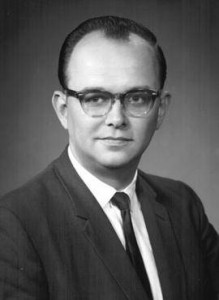
Like Einstein, the young Hugh Everett III found the notion of wave-function collapse untenable. Why, at the moment of measurement, should a well behaved Schrödinger wave-function change instantly to zero everywhere except at one unpredictable point where its value would be 100%? (You can see here my argument for why wave function collapse cannot be real.) In an animated discussion fuelled by a deal of sherry at a Princeton party (where he was a graduate student), it dawned on Everett that the problem could be avoided altogether. Instead of thinking always of wave-functions of isolated systems like the two-slit experiment, surely one should consider the wave-function of the entire universe?
The idea was that, wherever in the universe a measurement – or, indeed, any event at all – occurs at any time, then the universal wave function does not collapse but, instead, it branches out, the “thickness” of the branches being determined by the quantum probability of the occurrence of each branch. The profound implication of this idea is that, since the universal wave-function is “splitting”, to use Everett’s term, we, the observers in the universe, also split.
Someone suggested that he take the idea to John Archibald Wheeler, who was also at Princeton and who had done postdoctoral research under Bohr in Copenhagen. So Wheeler became Everett’s academic adviser. Everett wrote down his ideas in a 137-page draft of his dissertation and presented it to Wheeler in the spring of 1956. Wheeler had some misgivings about the work – it was so radical – but, in fairness, he believed that such a fundamental idea must be published and so he took the draft with him to Copenhagen in order to show it to Bohr at his Institute for Theoretical Physics.
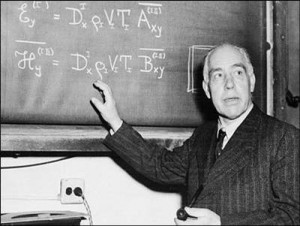
For Everett, it was a disaster. Bohr was quite unmoved by the ideas in the manuscript – a colleague at the Institute even derided it as “theology” – and Wheeler, not wanting to upset his old mentor, found himself in the role of apologist for Everett, explaining (quite wrongly) that Everett was not, in fact, challenging Bohr’s concept of wave function collapse.
Shortly after this, Everett left the field of theoretical physics altogether, taking a job at the Pentagon, thus avoiding being drafted into the military. Nevertheless, over the next year, Wheeler persuaded Everett to cut his dissertation to a quarter of its length, omitting the incendiary references to “splitting”, before submitting it for his PhD, which was duly awarded without further difficulty. This abridged dissertation was also published in 1957 in Reviews of Modern Physics, accompanied by a paper by Wheeler promoting the work. Sadly, despite Wheeler’s endorsement, the paper went virtually unremarked by the physics establishment: it was, as events were to prove much later, simply too far ahead of its time.
In a final, unhappy epilogue, at Wheeler’s insistence, Everett went to visit Bohr in Copenhagen in 1959. However, although the two met as planned, Bohr, now 75, refused even to discuss Everett’s “upstart theory”. In a curious twist of fate, though, while staying in Copenhagen, Everett came up with an idea for using a branch of mathematics to solve optimization problems in a broad range of practical situations in both the military and civilian sectors. This idea was to be the basis of a company which he headed five years later, when he left the Pentagon.
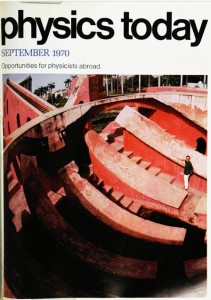
It was over a decade later, in 1970, that Bryce DeWitt, a physicist who happened to have received a copy of Everett’s thesis back in 1957, wrote an article that ensured Everett would be credited forevermore as the author of the Many Worlds Interpretation of quantum mechanics. The article, in Physics Today and entitled “Quantum Mechanics and Reality”, had an intriguing and provocative subtitle: “Could the solution to the dilemma of indeterminism be a universe in which all possible outcomes of an experiment actually occur?”.
This paper stimulated a far greater response from its readers than Everett’s original paper ever had, perhaps because it was clearly written and therefore more accessible to a wider readership, but maybe also because enough time had passed for a new generation of physicists to emerge from the shadow of Bohr (he had died in 1962) and could begin once more to question the apparent paradoxes of quantum mechanics.
The term “many worlds” was DeWitt’s, and the phrase soon caught the public imagination, even extending to science fiction, in a way that left Everett’s equivalent term, “universal wave-function”, out in the cold.

Figure 1 shows Everett’s interpretation of the universe splitting into many worlds for the entanglement experiment described in the Quantum Entanglement page. Alice sets her spin-filter at 0° (which is called her spin-up direction) and Bob sets his at 120° (which, in turn, is his spin-up direction). The trunk of the “tree” represents the state before Alice and Bob make their measurements. The diagram is drawn from Alice’s point of view and shows the universe splitting into two equal branches, with the left containing the event where Alice detects an “up” spin (½Au) and the right where she detects a “down” spin (½Ad). The “½” refers to the probability that Alice observes a particular outcome.
The question mark, “?”, in ½AuB? and ½AdB?, indicates Alice’s initial ignorance of Bob’s result. This is because information cannot reach her from Bob instantaneously.
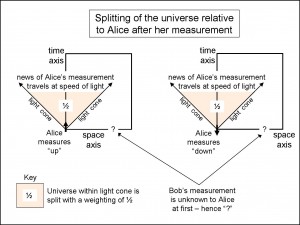
Figure 2 illustrates the two branches with the two possible outcomes of Alice’s experiment, spin “up” or spin “down”. At the moment Alice makes her measurement, imagine a spherical bubble spreading like a radio newsflash at the speed of light centred on Alice’s apparatus. Wherever you are in the universe, once the wave front of this bubble has passed you, you can, in principle, know Alice’s result. Equally, you cannot know it until the wave front reaches you. Inside this expanding spherical shell there are two possible worlds: one where Alice measured spin-up and one where she measured spin-down.
These are the two alternative worlds shown in the figure, and they correspond to the two main branches of the tree in Figure 1. Of course, in the picture, the news-bubble doesn’t look like an expanding spherical shell because I have drawn only one spatial dimension. Instead, you see a triangle expanding upwards with the diagonal edges being the usual 45° lines that indicate a pulse of light (see The Block Universe). This triangle is called a “light cone”. Within the light cone the universe, relative to Alice, is splitting into two. (Incidentally, “worlds” in DeWitt’s terms are what we understand as universes.)

In Figure 3 you see the totality of the two parts of the entanglement measurements. Four universes are shown. In the top-left, both Alice and Bob have measured spin-up, although, in the lightly shaded areas neither knows the other’s result. So the “½” refers in each case only to Alice’s perspective or only to Bob’s – there has not been time for light to travel from one result to the other.
Just to be clear, in this thought-experiment, we are supposing the same results that we worked out in the Quantum Entanglement page. Alice and Bob individually have 50% chance of measuring either spin-up or spin-down, but, when we compare their results, we shall find that their results match in ¾ of their experiments, being both either spin-up or spin-down.
In the top-right universe in Figure 3, again Alice has measured spin-up, but Bob has measured spin-down in this one. These two universes together, the top-left and the top-right, include the situation which is shown developing in the left-hand universe of the previous Figure 2, where Alice has measured spin-up but doesn’t yet know what Bob has found.
In both the top-left and the top-right universes of Figure 3, the region where the two triangles expanding from Alice’s and Bob’s measurements overlap has been shaded more heavily. Throughout this region, news of both results has had time to arrive, and so this region represents the complete split: here, not only has Alice split but Bob has also split.
Notice that another number has been drawn in this region of complete splitting. In the top-left universe, the region of complete splitting has a fraction ⅜ in it. This is the probability that Alice and Bob will find themselves in this particular split. That is consistent with their results: both results are spin-up and therefore match each other. The reason why this is ⅜ rather than ¾ is that the probability of ¾ includes the other possibility of both results being spin-down, and ⅜ is the probability of only one of the matches, in this case, both spin-up.
The bottom two universes show similar cases where Alice measures spin-down.
These four universes could equally have been read from Bob’s perspective by taking the first pair – the top-left and the bottom-left as showing what happens when Bob measures spin-up, and the top-right and bottom right showing Bob measuring spin-down.
Everett argued that each of these four universes emerges quite naturally from the wave-function describing the two measurements by Alice and Bob without having to bolt on the controversial collapse. So the wave-function of the universe never collapses. The consequence, though, is that each of the resulting universes (four in this case) must be regarded as equally real.
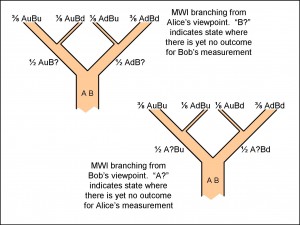
Figure 4 shows how the universes in Figure 3 are accommodated in the Many-Worlds picture. Notice that the topologies of the two pictures in Figure 4 are different, depending upon the point of view of the observer. Thus, in the top-left picture, the thin branch ending in ⅛AuBd bifurcates with the thicker branch ending in ⅜AuBu, whereas, in the bottom-right picture, that same ⅛AuBd branch bifurcates with a different branch, ⅜AdBd. The overall result, ⅜AuBu, ⅛AuBd, ⅛AdBu, ⅜AdBd, is the same in either case. However, the fact that the detailed topologies depend upon the viewpoints of different individuals indicates that all is not well with the Many-Worlds picture. It is left once again to special relativity to deliver the coup de grace, as we shall see in the next section, Parallel Block Universes.
Click here to go to [10] Parallel Block Universes page
